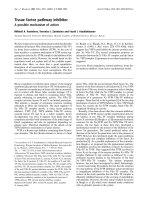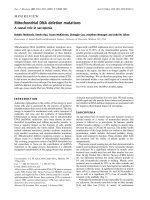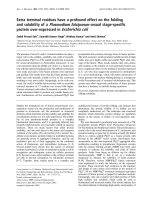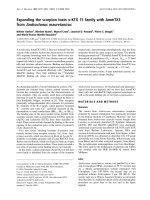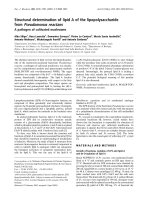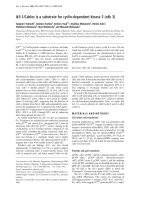Báo cáo y học: "Transcription, one allele at a time" ppsx
Bạn đang xem bản rút gọn của tài liệu. Xem và tải ngay bản đầy đủ của tài liệu tại đây (445.96 KB, 4 trang )
Transcription of a gene into its messenger RNA occurs
through a series of defined steps, from transcription
factor binding at the promoter to pre-initiation complex
formation, entry into elongation and finally termination
[1]. Most of the players in these processes, such as the
general transcription factors associated with the RNA
polymerase, elongation factors, and termination factors,
are now well known. However, transcription is inherently
a highly dynamic process [2], which sets obvious experi-
mental challenges to most biochemical methods. In this
context, imaging techniques have emerged as important
tools to study the rapid succession of events that
constitute transcription in real time [3]. Watching single
cells over time also discloses details that are obscured in a
typical test-tube experiment in which the outputs of
millions of cells are averaged. Such details can indeed be
quite dramatic, such as the high-amplitude oscillations
observed in the case of the signaling pathway that
activates the transcription factor NFκB [2]. Negative-
feedback loops within the NFκB pathway generate cyclic
subcellular accumulation of signaling proteins, which
results in oscillations in the transcriptional activity of
their target genes.
In a recent study published in Nature Methods, Yaron
Shav-Tal and colleagues (Yunger et al. [4]) push the limits
of transcription imaging further. ey take advantage of
the MS2 system developed a decade ago [5], in which a
DNA sequence from the bacteriophage MS2 - the MS2
binding site (MBS) - is inserted into a gene of interest.
When transcribed, this sequence folds into a stem-loop
structure that can be bound with high affinity by the
bacteriophage capsid protein (MCP). Coexpression of the
MBS-gene construct with one in which MCP is fused to a
fluorescent protein gives you an endogenous reporter
system that allows the detection of single molecules of
mRNA (Figure 1a).
The MS2 RNA reporter system combined with
site‑specic recombination
Using the MS2 system, details of mRNA transcription,
diffusion and nuclear export have been revealed in many
different organisms, from bacteria to fruit flies to
mammalian cells [3]. Up to now, however, genomic
integration of MS2-tagged gene constructs using tradi-
tional techniques (such as plasmid integration or viral
infection) has resulted in the integration at a random
genomic location of an array containing multiple copies
of the gene of interest [6]. Although these arrays confer
high amplification of fluorescent signal, they come with
drawbacks. First, the real-time signal from one fluor-
escent mRNA gets blurred by signals from the hundreds
of unsynchronized fluorescent mRNA molecules present
at the gene array. Second, features specific to repeated
sequences, or to the locus of integration (which is
random), might interfere with transcriptional regulation
of the gene of interest. Advances in light microscopy and
fluorescent probe development have now brought the
detection of single mRNA molecules within reach, and as
a result, the limitations of the gene arrays are beginning
to outweigh their advantages. However, all studies at the
single-gene level in mammalian cells are hindered by the
complexity of the genetic techniques required (for
example, the need to make transgenic animals).
To overcome the problem of repeated gene sequences
and random insertion, Yunger et al. [4] combined the
MS2 system with a site-specific recombination system.
ey start from a host human cell line the genome of
which harbors a single specific recognition site (FRT) for
the yeast FLP recombinase. Co-transfection of the cell
line with plasmids that contain the recombinase and the
MBS-tagged gene flanked by the FRT sequence results in
a single insertion of the construct at the genomic FRT
site. A host cell line with the desired characteristics and
with a stable site for MS2-tagged gene insertion can
readily be prepared by integrating the recombinase-
recognition site sequence FRT into a cell line of choice
Abstract
A recent study presents a technique allowing one
to image transcription from a single gene copy
in live cells, and highlights the dynamic nature of
transcriptional regulation.
© 2010 BioMed Central Ltd
Transcription, one allele at a time
Timothée Lionnet
and Robert H Singer*
R E S E A R C H H I G H L I G H T
*Correspondence:
Department of Anatomy and Structural Biology, Albert Einstein College of
Medicine, Bronx, New York, NY 10461, USA
Lionnet and Singer Genome Biology 2010, 11:129
/>© 2010 BioMed Central Ltd
(the FRT site itself inserts at random, however, and this
initial step cannot be controlled).
In this way, they were able to insert just a single copy of
a gene of interest along with its MBS repeats at a specified
location in the genome of a host human embryonic
kidney cell line (Figure 1b). e other player of the
system, the fluorescent MCP, was expressed through
tran sient transfection. is approach considerably
simpli fies the generation of standardized mammalian cell
lines that express reporter mRNAs at a consistent
genomic locus. As proof of efficacy, the authors used
their new technique to compare the expression of the
same reporter gene (human cyclin D1) transcribed under
the control of two different promoters: the cytomegalo-
virus (CMV) promoter (CMVpr), which is broadly used
to achieve high expression levels of exogenous proteins;
and the cyclin D1 promoter (CCND1pr), which is
apparently active at a constant level throughout the cell
cycle [7]. e genetic construction guarantees that the
genomic context is identical in the two cell lines, and that
the observed differences originate only from promoter-
dependent regulation. e authors then demonstrate the
versatility of their system using a battery of fluorescence
imaging techniques. e CCND1 and CMV promoters
were chosen to drive expression of the cyclin D1 gene for
this particular experiment, but in principle any gene-
promoter combination could be used in this system.
In addition to providing proof of principle of the new
technique, the experiments presented by Yunger et al. [4]
describe how two promoters can differ in their control of
transcription. e average number of reporter mRNA
molecules per cell in the CMVpr cell line is more than
double that in the CCND1pr cell line (114 compared with
41). Consistent with the total numbers of mRNA
molecules, more nascent mRNA chains were observed
on average at the reporter gene locus in the CMVpr cell
Figure 1. Imaging transcription from a single allele. (a) The principle underlying the MS2 mRNA reporter system. RNA polymerases (brown)
initiating transcription from the promoter (blue) progress along the reporter gene (green). Upon reaching the cassette of MBS sequences (orange),
each MBS sequence (usually 24 in all) forms a stem-loop in the nascent mRNA. Coexpressed uorescently tagged MCP protein (MCP-GFP) binds
the stem-loops, resulting in a uorescent mRNA particle that can be detected by uorescence microscopy. (b) Insertion of the MS2 construct into
host cells by site-specic homologous recombination. A plasmid containing a promoter-gene construct (blue/green) and an MBS cassette (orange)
upstream of the recombination target sequence (FRT, red triangle) is transfected into a cell line that harbors a single FRT sequence (red triangle)
within its genome. Homologous recombination mediated by coexpression of the FLP recombinase (not shown) results in the integration of the
reporter gene at that FRT site. CCND1 promoter and reporter sequences are shown here, but any combination of promoter and reporter sequence
could be used.
Pol II
+MCP-GFP
24x
CCND1CCND1pr
+
(a)
24x
CCND1CCND1pr
(b)
24 x MBS
24x
Lionnet and Singer Genome Biology 2010, 11:129
/>Page 2 of 4
line compared with the CCND1pr cell line (average of 14
versus 7 nascent chains over a cell population).
Burst‑like activity of the cyclin D1 promoter
e authors went on to measure the intensity of the
fluorescence emitted by the nascent chains at the
reporter gene locus in real time, which correlates with
the number of RNA polymerases present on the gene
downstream of the MBS cassette. In the CMVpr cell line,
the intensity fluctuated slightly over time around its
mean value, reflecting small variations in the number of
elongating polymerases present. e CCND1pr cell line
displayed strikingly different behavior. Periods of intense
transcriptional activity alternated with periods where no
fluorescence was detected. ese bursts of activity
occurred over periods ranging from minutes to hours -
the average duration of the ON state was 200 minutes,
while the duration of the OFF state averaged 22 minutes.
is is a direct observation showing that promoters not
only tune the global output of transcription (the average
level) but also its kinetics: the gene associated with the
CMV promoter remains on at all times, with a high
number of engaged polymerases. e CCND1 promoter,
in contrast, alternates between ON and OFF states, with
an overall lower number of engaged polymerases. ese
bursts are not necessarily incompatible with previous
observations of constant cyclin D1 transcription levels
over the cell cycle [7]: as the pulses occur at time scales
shorter than that of the cell-cycle phases, fluctuations
might average out over time to generate a constant output.
Kinetic modeling suggests that the differences observed
in the number of nascent RNA chains at the gene results
from variation in the initiation frequency (one transcript
initiated every 22 seconds for the CMVpr compared with
one every 52 seconds for the CCND1pr), rather than to
differences in elongation rate. ese results confirm the
common view that the main lever for transcription
regulation is the efficiency of the promoter-dependent
recruitment of elongating complexes (PolII combined
with its necessary cofactors).
Taken together, these quantitative measurements draw
a detailed picture of the regulation of mRNA production
from two different promoters. e initiation rate t
i
combined with the mean number of molecules of a given
mRNA per cell (m) can be used to estimate the RNA’s
half life t
d
(t
d
= mt
i
), which is 42 minutes for RNA
transcribed from the CMV promoter and 32 minutes for
the same RNA transcribed from the CCND1 promoter,
values close to the 30 minutes estimated for endogenous
CCND1 mRNA [8]. Interestingly, the lifetime of these
mRNA molecules is longer than the OFF state of the
CCND1 promoter: in this case, transcription does not
shut down long enough to significantly deplete the cell of
its mRNAs. e outcome for the CCND1 promoter is a
wide but single-peaked distribution of the number of
mRNAs per cell, and shows that OFF states are not a
stable feature leading to a phenotype of low mRNA copy
number, but instead contribute dynamically to regulate
the number of mRNA molecules within the cell.
Pulses of transcription have already been observed in
reporter systems in bacteria and in endogenous genes in
the slime mold Dictyostelium discoideum and in cultured
mammalian cells, whereas data on constitutively expressed
genes in yeast suggest that these are transcribed via a
constitutive, single-step initiation process [9]. Even if not
the rule, bursts of transcription seem to be a possible
mode of transcription regulation in higher eukaryotes.
One possible advantage is that generating bursts of
transcripts provides the cell with more regulatory
options: increasing the average level of expression can be
achieved by increasing the burst frequency, the burst
duration or the number of molecules per burst. Each of
these options can be governed by different molecular
interactions involving different cofactors.
What could be the mechanism behind such trans-
cription pulses? e fact that this phenomenon was only
observed at one of the two promoters studied rules out
bursting as an intrinsic feature of eukaryotic gene
expression - for example, to effect a large-scale transition
to ‘open’ transcribable chromatin. Low-frequency bind-
ing of transcription factors could be one explanation.
Detailed statistics of the times spent in the OFF/ON
states in the case of the CCND1 promoter could provide
further information on the number of hidden bio-
chemical steps leading to gene activation or shutdown,
and therefore help to build a better model describing the
kinetics of transcription and its contribution to mRNA
copy-number variability [10].
Transcription and DNA replication
Another important question is what happens during
DNA replication when the replication fork has to go
through an actively transcribing gene. Do RNA poly-
merases get displaced? In contrast to prokaryotes, little is
known about how replication and transcription interact
at the molecular level in mammalian cells. While Yunger
et al. [4] were observing cells in S-phase (DNA repli-
cation) and the following G2 phase, they would some-
times observe a site of transcription separate into two
less intensely fluorescent sites, suggesting that these sites
were the replicated copies of the gene on the sister
chromatids. Analysis of the fluorescence intensity at the
gene up to 3 hours before such site duplications revealed
no transcriptional shut down, indicating that the passage
of the replication fork might not fully displace engaged
polymerases from their template. Interestingly, measur-
ing fluorescence recovery after photobleaching (FRAP) at
the duplicated sites revealed slower kinetics of recovery
Lionnet and Singer Genome Biology 2010, 11:129
/>Page 3 of 4
than at unduplicated sites. All these observations suggest
how the MS2 system could be put to use to study the
molecular details of collisions between elongating RNA
polymerases and replisomes, for example, by multi-
plexing the imaging of nascent mRNA with that of
replication-fork progression.
e technique presented by Yunger et al. [4] provides
an important tool for single-gene imaging studies in cell
lines: a convenient system that provides a standardized
genomic context, in which all inserted constructs experi-
ence the same local environment (such as chromatin
state or the influence of enhancers). Any promoter-gene
combination can potentially be inserted (along with its
MBS cassette) into the host cell line, opening up
approaches to live-cell transcription studies. By com-
bining the MS2 system with a site-specific recom bination
system, Yunger et al. have considerably simplified and
standardized its use as a quantitative, single-molecule
mRNA fluorescent reporter. Given the richness of detail
provided by their experiments, we anticipate that their
system will be a valuable tool for those studying trans-
cription. It also constitutes an important step towards the
ultimate goal of studying the expression of a fully
endogenous gene in single cells over time.
Acknowledgements
TL is supported by an HFSP long-term Fellowship. RHS acknowledges the
support of NIH grants GM86217 and GM57071.
Published: 27 August 2010
References
1. Fuda NJ, Ardehali MB, Lis JT: Dening mechanisms that regulate RNA
polymerase II transcription in vivo. Nature 2009, 461:186-192.
2. Hager GL, McNally JG, Misteli T: Transcription dynamics. Mol Cell 2009,
35:741-753.
3. Darzacq X, Yao J, Larson DR, Causse SZ, Bosanac L, de Turris V, Ruda VM,
Lionnet T, Zenklusen D, Guglielmi B, Tjian R, Singer RH: Imaging transcription
in living cells. Annu Rev Biophys 2009, 38:173-196.
4. Yunger S, Rosenfeld L, Garini Y, Shav-Tal Y: Single-allele analysis of
transcription kinetics in living mammalian cells. Nat Methods 2010,
7:631-633.
5. Bertrand E, Chartrand P, Schaefer M, Shenoy SM, Singer RH, Long RM:
Localization of ASH1 mRNA particles in living yeast. Mol Cell 1998,
2:437-445.
6. Darzacq X, Singer RH, Shav-Tal, Y: Dynamics of transcription and mRNA
export. Curr Opin Cell Biol 2005, 17:332-339.
7. Guo Y, Stacey DW, Hitomi M: Post-transcriptional regulation of cyclin D1
expression during G2 phase. Oncogene 2002, 21:7545-7556.
8. Keyomarsi K, Pardee AB: Redundant cyclin overexpression and gene
amplication in breast-cancer cells. Proc Natl Acad Sci USA 1993,
90:1112-1116.
9. Chubb JR, Liverpool TB: Bursts and pulses: insights from single cell studies
into transcriptional mechanisms. Curr Opin Genet Dev 2010, doi:10.1016/j.
gde.2010.06.009.
10. Paulsson J: Models of stochastic gene expression. Phys Life Rev 2005,
2:157-175.
doi:10.1186/gb-2010-11-8-129
Cite this article as: Lionnet T, Singer RH: Transcription, one allele at a time.
Genome Biology 2010, 11:129.
Lionnet and Singer Genome Biology 2010, 11:129
/>Page 4 of 4
